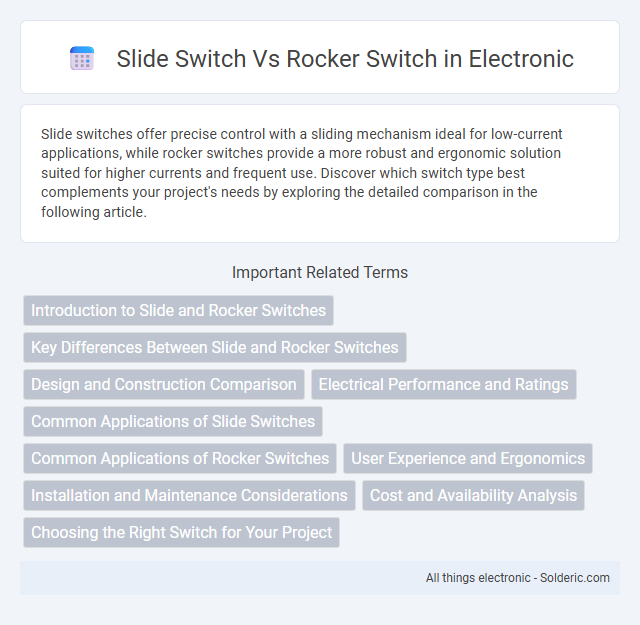Slide switches offer precise control with a sliding mechanism ideal for low-current applications, while rocker switches provide a more robust and ergonomic solution suited for higher currents and frequent use. Discover which switch type best complements your project's needs by exploring the detailed comparison in the following article.
Comparison Table
| Feature | Slide Switch | Rocker Switch |
|---|---|---|
| Operation | Sliding motion to toggle on/off | Rocker motion pivoting to toggle on/off |
| Design | Rectangular, narrow slider | Curved or flat rocker surface |
| Applications | Small electronics, circuit boards | Household appliances, power tools |
| Durability | Moderate, suited for low current | High, handles higher current loads |
| Contact Type | Single or multi-pole slide contacts | Snap-action contacts for quick switching |
| mounting | PCB or panel mount | Panel mount commonly |
| Cost | Generally lower | Usually higher |
Introduction to Slide and Rocker Switches
Slide switches and rocker switches are common types of electrical switches used to control circuits by opening or closing them. Slide switches operate by sliding a button or lever horizontally or vertically to change the electrical connection, making them suitable for compact electronic devices. Rocker switches feature a rocking mechanism that tilts the switch back and forth, providing a tactile feel and clear on/off positions ideal for appliances and power tools.
Key Differences Between Slide and Rocker Switches
Slide switches feature a sliding mechanism to open or close circuits, providing precise control for low-current applications, while rocker switches operate with a rocking motion, often used for higher current loads and household appliances. Key differences include their actuation style, with slide switches offering a linear movement and rocker switches providing a pivoting action, impacting usability and tactile feedback. Your choice depends on the specific electrical requirements and ergonomic preferences for your project or device.
Design and Construction Comparison
Slide switches feature a compact, linear design with a small sliding actuator that moves horizontally to open or close circuits, making them ideal for low-profile applications and precise control. Rocker switches have a larger, pivoting actuator that rocks back and forth to toggle a circuit on or off, offering a more robust construction suited for higher current ratings and frequent use. The choice between the two depends on factors such as space constraints, durability requirements, and the intended electrical load.
Electrical Performance and Ratings
Slide switches typically offer moderate electrical performance with voltage ratings up to 250V AC and current ratings ranging from 0.1A to 5A, making them suitable for low to medium power applications. Rocker switches generally provide higher electrical ratings, often handling currents up to 20A and voltages of 125V to 250V AC, which makes them ideal for more demanding electrical loads. When selecting a switch, your choice should consider the required current and voltage specifications to ensure reliable and safe operation.
Common Applications of Slide Switches
Slide switches are frequently used in small electronic devices such as handheld gadgets, toys, and portable audio equipment due to their compact size and reliable on/off functionality. They are ideal for circuit board-level control in applications where space is limited, including battery-operated devices and computer peripherals. The simplicity of slide switches also makes them a popular choice for user interfaces requiring tactile feedback without complex mechanisms.
Common Applications of Rocker Switches
Rocker switches are commonly used in household appliances, power strips, and automotive dashboards due to their easy operation and clear on/off indication. Their durability and tactile feedback make them ideal for industrial equipment and control panels, where reliable switching is crucial. You'll often find rocker switches controlling lights, fans, and electronic devices in both residential and commercial settings.
User Experience and Ergonomics
Slide switches offer precise control with a smooth, linear motion that enhances user experience by minimizing accidental activation, making them ideal for applications requiring fine-tuned adjustments. Rocker switches provide tactile feedback through a rocking motion, which is ergonomically favorable for quick, confident toggling in low-visibility or one-handed operation scenarios. Your choice depends on whether you prioritize subtle adjustment or ease of use in various physical environments.
Installation and Maintenance Considerations
Slide switches typically offer straightforward installation with soldered terminals or PCB mounts, making them suitable for compact electronic devices where space is limited. Rocker switches often feature snap-in panel mounting or threaded bushing installation, providing ease of replacement and access in larger equipment or control panels. Maintenance for slide switches may require desoldering for repair or replacement, while rocker switches allow quicker servicing due to accessible mounting designs and standardized sizes.
Cost and Availability Analysis
Slide switches typically offer lower cost and high availability, making them ideal for budget-conscious projects and mass production. Rocker switches, while generally more expensive, provide enhanced durability and a wider variety of styles, often found readily in specialized electronics suppliers. Your choice depends on balancing upfront investment with long-term reliability needs.
Choosing the Right Switch for Your Project
Slide switches offer compact, low-profile designs ideal for precise on/off control in small electronics, while rocker switches provide robust, easy-to-use toggling suitable for higher current applications and industrial settings. Your choice depends on factors such as current rating, installation space, and user interface preferences, with slide switches excelling in limited-space environments and rocker switches favored for durability and clear tactile feedback. Evaluating these parameters ensures reliable functionality and optimal user experience for your project's specific needs.
Slide switch vs Rocker switch Infographic

 solderic.com
solderic.com